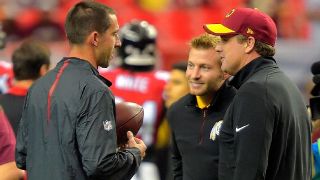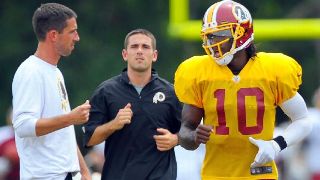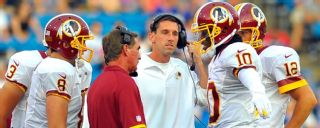|
The coaching talent was obvious, but the coaches were just young -- in some cases, too young to even rent a car. But it was a group that helped develop one of the NFL's most dynamic offenses for a season in Washington, and eventually delivered head coaches to three different teams. When Matt LaFleur was hired last week by the Green Bay Packers, he became the third former Redskins assistant coach under Mike Shanahan to be hired as an NFL head coach. One of the others, Sean McVay, is preparing his team for the NFC Championship Game in only his second season with the Los Angeles Rams. Kyle Shanahan just finished his second season with the San Francisco 49ers. Shanahan and LaFleur were fired by Washington after the 2013 season; McVay stayed through 2016, when he then accepted the Rams' job. Each one helped the other, said Mike Shanahan, the Redskins' head coach from 2010 to 2013. "When guys are really driven and want to learn the game and all of a sudden someone knows something someone else doesn't, they want to know what that guy knows," Shanahan said. "When you have coaches like that, you get a lot better. A lot of guys are experts at their position, but could care less to understand the total game. But guys that want to know everything usually get an opportunity to be a coordinator or head coach." That's what happened with this group. At the time Shanahan compiled this staff, there was some criticism that he was simply allowing his son to hire his friends. Turns out, they were gathering good, young minds. They all run a variation of a West Coast system, with each one including wrinkles from various stops; McVay incorporated some of Jay Gruden's offense, for example. But each of the three shared a core belief in what they ran in Washington. It also helped that Mike Shanahan would have his coaches present their offense in front of the defensive coaches and vice versa. It sharpened their ability to present in front of a group -- a key skill for a coordinator or head coach. "You have guys that really understand what was going on when they were coaching together," Shanahan said. "They had a system they believed in. Obviously every coach is as good as his personnel. ... You have to have a system that gives you a chance and then in turn to put people in situations so they can attack a defense."  For Mike Shanahan, the ascension of this group started with Kyle Shanahan and what he had done in Houston in 2008 and 2009, the two years before joining his father's staff. The Texans, with Kyle as the offensive coordinator, finished fourth and third, respectively, in yards per game, and improved from 17th to 10th in points. For Mike Shanahan, the ascension of this group started with Kyle Shanahan and what he had done in Houston in 2008 and 2009, the two years before joining his father's staff. The Texans, with Kyle as the offensive coordinator, finished fourth and third, respectively, in yards per game, and improved from 17th to 10th in points.
"You could see it in the play-action game and you could see it in the drop-back game," Mike Shanahan said. "When people get an opportunity to be a coordinator and call plays for a couple years, you take a look at what they're thinking compared to what they've done in the past. Guys who make their offense grow, what they usually do in the offseason is study everyone in the NFL and say how can we make our offense better, what can we do to go from the middle of the pack to the top five? If you have those types of coaches on your staff and then combine that with some better players, you have a chance to get into the top five." In 2010, the Redskins ranked 18th in yards and 25th in points. By 2012, they had nine new starters, including dynamic rookie quarterback Robert Griffin III. That season, the Redskins ranked fifth in yards and fourth in points while taking the zone-read option to new levels in the NFL. Griffin won Rookie of the Year honors, throwing for 3,200 yards and rushing for 815. That season, Kyle Shanahan was still coordinator with LaFleur as the quarterbacks coach and McVay coaching the tight ends. "What they did was the same things that had been done before," Mike Shanahan said. "We just implemented it with what Robert did best. That was a running game with maybe three or four running plays with the same play-action game with it." Shanahan said he knew there was something different about McVay. He started with the Redskins in 2010 when he was 23 years old, serving as an assistant tight ends coach. He became the full-time tight ends coach in 2011. Shanahan liked how McVay took a big-picture approach. "You could see right away Sean embraced it and embraced knowing the strengths and weaknesses of a defense and all the things as a head coach you're hoping your coaches have, but very seldom have," Shanahan said. "Usually guys know their positions and very few want to know everything or have the ability to learn everything. "I knew right away and I told many people even after the first year he was with me that it won't be long before he's a coordinator because of his thirst for knowledge and [desire] to understand everything on both sides and the ability to communicate with people. You just knew it was going to happen."  McVay became Gruden's offensive coordinator in 2014 and, after calling plays for most of three years, was hired by the Rams as head coach at age 30. LaFleur had the longest wait of the three, going to Notre Dame in 2014 as quarterbacks coach before joining Kyle Shanahan with the Atlanta Falcons a year later for two more seasons. He then went to the Rams, serving as McVay's offensive coordinator (though not calling plays) for one season. LaFleur called plays in Tennessee this past season. Like Kyle Shanahan, he's only 39. McVay became Gruden's offensive coordinator in 2014 and, after calling plays for most of three years, was hired by the Rams as head coach at age 30. LaFleur had the longest wait of the three, going to Notre Dame in 2014 as quarterbacks coach before joining Kyle Shanahan with the Atlanta Falcons a year later for two more seasons. He then went to the Rams, serving as McVay's offensive coordinator (though not calling plays) for one season. LaFleur called plays in Tennessee this past season. Like Kyle Shanahan, he's only 39.
"Matt didn't have the background that Sean or Kyle had," Shanahan said. "He's got a lot of confidence because he's been going at it for five years. He's going to have to depend on coaches help him because he's only in his second year calling plays. With that there's a learning curve; all coaches go through it." But Shanahan knows why Green Bay hired him, even though LaFleur spent only one year calling plays. He pointed to the success the offense had in Atlanta as well as with the Rams the past two years. "It proves if you do get players in the system, you can be a top offense in the league," Shanahan said. "That's why people take a chance with a guy like Matt. They've gotten that opportunity maybe a year or two earlier than normal just because of the success they had and because they wanted a guy that's part of a system like that. It makes sense." Despite the offensive brain power, for a variety of reasons the Redskins posted one winning season in their four years together. Still, Shanahan says he feels satisfaction from this trio's rise. "Guys like Sean and Kyle and Matt, they really studied to get to know the strengths and weaknesses of a defense," Shanahan said. "Now they're in position to give themselves a chance to win a Super Bowl. It's fun to see."
|

